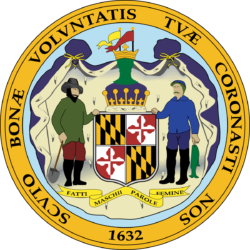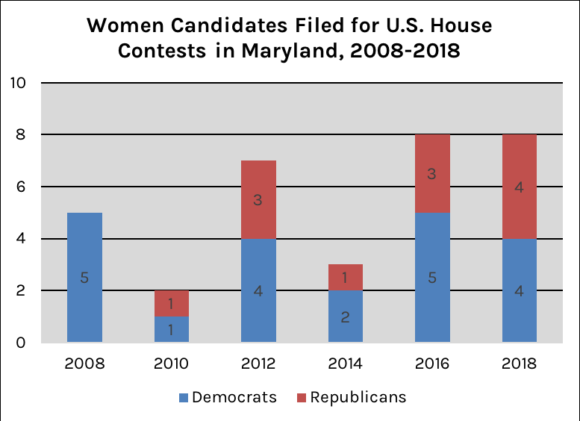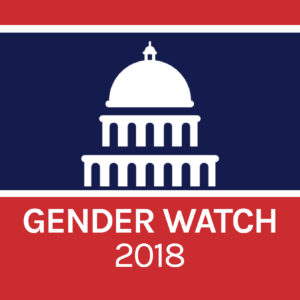
Ahead of the Maryland primary election on June 26, 2018, we outline the numbers and proportions of women who have filed as candidates for congressional and statewide office. The data below also provide points of historical comparison to give context to today’s presence and potential success of women candidates.
All data are provided from the Center for American Women and Politics, Eagleton Institute of Politics, Rutgers University. For a full list of the women candidates in Maryland primary races for congressional and statewide offices, see CAWP’s Election Watch page.
CONGRESS
Current: 0 of 10 members of the Maryland congressional delegation (0%)
Filed: 13 (8D, 5R)
Percent of all Filed Congressional Candidates (D/R): 17.6% (13 of 74)
* Maryland is one of 11 current states to have no women representing it in Congress.
SENATE
Current: 0 of 2 senators
- One woman – Barbara Mikulski (D) – has represented Maryland in the U.S. Senate.
Filed: 5 (4D, 1R)
- 4 (4D) women candidates are challenging incumbent Senator Ben Cardin (D) for the Democratic nomination.
- 1 (1R) woman candidate is running for the Republican nomination to challenge the Democratic incumbent in November.
Percent of all Filed Senate Candidates (D/R): 26.3% (5 of 19)
Percent of all Filed Democratic Senate Candidates: 50% (4 of 8)
Percent of all Filed Republican Senate Candidates: 9.1% (1 of 11)
HOUSE
Current: 0 of 8 representatives (0%)
- 8 (5D, 3R) women have served in the U.S. House from Maryland.
Filed: 8 (4D, 4R)
- 4 (2D, 2R) women are running in the open seat contest in MD-06.
- 4 (2D, 2R) women are running as challengers, including 1 (1D) woman candidate challenging an incumbent of her own party in MD-08 and 3 (1D, 2R) women candidates seeking the nominations to challenge incumbents in MD-01, MD-02, and MD-08 this fall.
* 5 (3D, 2R) of 8 women candidates for U.S. House from Maryland are women of color, including 2 (2R) Black women, 2 (2D) Asian/Pacific Islander women, and 1 (1D) woman who identifies as multiracial. Maryland has previously sent one woman of color to the U.S. House: Donna Edwards (D), who is Black.
Districts with Women Candidates: 4 of 8
Percent of all Filed House Candidates (D/R): 14.5% (8 of 55)
Percent of all Filed Democratic House Candidates: 12.9% (4 of 31)
Percent of all Filed Republican House Candidates: 16.7% (4 of 24)

Recent history: The number of women who filed for major party candidacy for the U.S. House in Maryland in 2018 matches a previous high of 8 between 2008 and 2016. In 2016, when there were 2 open seats, 8 women candidates ran for the U.S. House. This year, there is one open U.S. House seat in Maryland.
- This year marks the highest number of Republican women running for the U.S. House in Maryland between 2008 and 2018, but not the highest number of Democratic women running for U.S. House.
GOVERNOR
Current: 0
No woman has ever served as governor of Maryland.
Filed: 2 (2D)
- 2 (2D) women filed to run for the Democratic nomination for governor, but Valerie Ervin recently withdrew from the race. That leaves Krish Vignarajah as the only woman still in contention for governor of Maryland.
- Vignarajah is South Asian and would be the first woman and woman of color governor of Maryland. She could also become the first (or among the first) Democratic woman of color governor nationwide.
Percent of all Filed Gubernatorial Candidates (D/R): 20% (2 of 10)[1]
Percent of all Filed Democratic House Candidates: 22.2% (2 of 9)
Percent of all Filed Republican House Candidates: 0% (0 of 1)
OTHER STATEWIDE ELECTED EXECUTIVE OFFICES
Current: 0 of 3 positions (excludes governor) (0%)
- Just one woman has ever been elected statewide in Maryland; Lieutenant Governor Kathleen Kennedy Townsend (R) (1995-2003).
Filed: 7 (6D, 1R)
- 6 (6D) women are running for lieutenant governor, selected by 5 men and 1 woman candidate for governor. Before withdrawing from the race, Valerie Ervin also selected a female running mate. She will not appear on the ballot.
- 1 (1R) woman is running to challenge the Democratic incumbent for state comptroller.
- There are no women candidates for attorney general.
Percent of all Filed Statewide Executive (other than governor) Candidates (D/R): 53.8% (7 of 13)
Percent of all Filed Democratic Statewide Executive (other than governor) Candidates: 60% (6 of 10)
Percent of all Filed Republican Statewide Executive (other than governor) Candidates: 33.3% (1 of 3)
Recent history: The number of women who filed for major party candidacy for the statewide executive offices (other than governor) in Maryland in 2018 is the highest in the past three statewide executive elections. In 2014, 6 (4D, 2R) women were candidates for statewide executive offices other than governor.
[1] This does not include Democratic candidate Kevin Kamenetz, who died after filing for candidacy. His name will appear on the ballot, but votes will be given to his lieutenant governor candidate Valerie Ervin. Ervin has since withdrawn from the race.


 From March to December 2018, the
From March to December 2018, the 